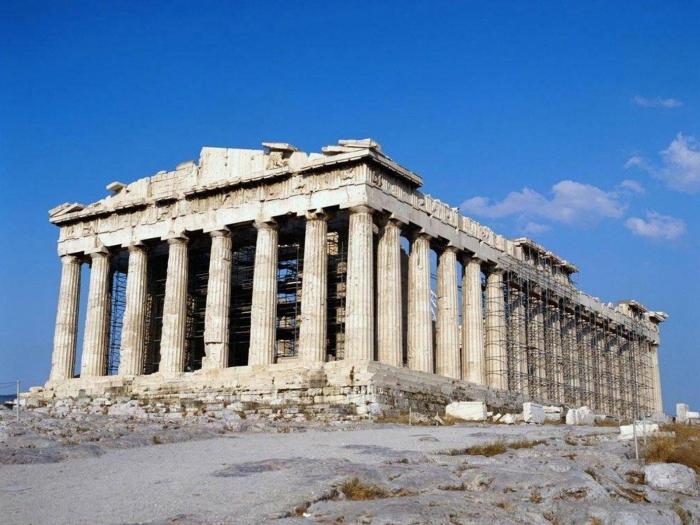The Acropolis in Athens began to be erected in the middle of the fifth century BC. The idea of this large-scale construction belongs to the ancient Greek ruler Pericles. At the initial stage, monumental gates and three temples were built. A little later two more theaters appeared here - Herodes Atticus and Dionysus.
Entrance gate
The covered marble gate, called the Propylaea, represents the entrance to the Acropolis in Athens. In the central part they have five large aisles, and on the sides there are portico-wings and small-sized halls with six columns. On the left side is the Pinacoteca. The construction of the gate was completed in the fifth century BC. At different times they had a different purpose. Once there was an archbishop's residence, then a crusader castle, and even later - a Turkish arms depot. It should be noted that the structure was badly damaged due to the ingress of a core during the war of Venice with Turkey in the seventeenth century. Restoration work was completed only after two centuries.
Parthenon
The Temple of Athena on the Acropolis, which is also known as the Parthenon, is now considered a symbol of the Greek capital. Its construction was led by Phidias, completed during the Peloponnesian war, and was dedicated to the goddess of the same name. The marble building is located on a high cliff, which is also lined with this material. On the frieze of the building are images depicting the events of the Trojan War. Around the temple are Doric columns, whose height is ten meters. Separate words deserve the statue of Athena in the Acropolis, which is made of ivory and gold. On her right hand is Nick. This monument was annually one of the constituent parts of the Panathenaic procession, which was accompanied by numerous contests and sacrifices. The ancient Greeks worshiped the goddesses Athena and Nika here. In addition, the temple served as an observation post. According to legend, it was from here that King Aegeus threw himself into the sea and crashed when he saw a black flag mistakenly hung on the ship, which meant the death of his son Theseus.

Erechtheion
The Acropolis of Athens is hard to imagine without the Erechtheion Temple. There is a legend that he is in the place where Athena and Poseidon entered into a dispute over city patronage. The structure is asymmetric, and its walls have many windows. Inside it there are three rooms. An interesting feature is that in the southern part the cornice is supported not by columns, but thanks to six caryatids (statues of girls). Now the originals of these columns can be seen in the local museum. In the temple are the shrines of mythical kings such as Kekrop and Erechtey.
Museum
Among other things, the Acropolis in Athens boasts the presence of its own museum, which was founded in 1878. It mainly presents the results of local excavations. It should be noted and the pediment of the temple of the goddess Athena. On it there are scenes of her triumph, as the victors of war. In addition, the museum also preserves pediment sculptures and some surviving sections of the Parthenon frieze.